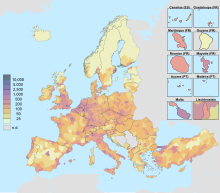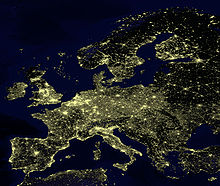
Back التركيبة السكانية للاتحاد الأوروبي Arabic Demografía de la Xunión Europea AST Население на Европейския съюз Bulgarian Demografia de la Unió Europea Catalan Obyvatelstvo Evropské unie Czech Demografie der Europäischen Union German Demografiya Yewiya Ewropa DIQ Demografía de la Unión Europea Spanish Euroopan unionin väestö Finnish Démographie de l'Union européenne French
| Demographics of the European Union | |
|---|---|
 Map showing the population density by NUTS3 region, 2017, including non-EU countries | |
| Population | 448,753,823 (2023)[1] |
| Growth rate | 0.37% (2022)[1] |
| Birth rate | 8.7 births per 1,000 (2022)[2] |
| Death rate | 11.5 deaths per 1,000 (2022)[3] |
| Life expectancy | 80.6 (2022)[4] |
| • male | 77.9 years (2022)[4] |
| • female | 83.3 years (2022)[4] |
| Fertility rate | 1.46 children per woman (2022) |
| Infant mortality rate | 3.3 deaths per 1,000 live births (2022)[5] |
| Language | |
| Official | See languages of the European Union |
| Spoken | Most spoken L1: German: 20% (2020)
Most spoken L2: English L2: 43% (2017)[6][7] [8] |



The demographics of the European Union show a highly populated, culturally diverse union of 27 member states. As of 1 January 2023, the population of the EU is around 448 million people.[1]
- ^ a b c "Population on 1 January". Eurostat. Retrieved 27 March 2024.
- ^ "Live births and crude birth rate". Eurostat.
- ^ "Deaths and crude death rate". Eurostat.
- ^ a b c "Life expectancy at birth by sex". Eurostat.
- ^ "Infant Mortality rate". Eurostat.
- ^ Cite error: The named reference
Wileywas invoked but never defined (see the help page). - ^ "Despite Brexit, English Remains The EU's Most Spoken Language By Far". Forbes.
- ^ "Eurobarometer" (PDF). Archived from the original (PDF) on 6 January 2016.
© MMXXIII Rich X Search. We shall prevail. All rights reserved. Rich X Search